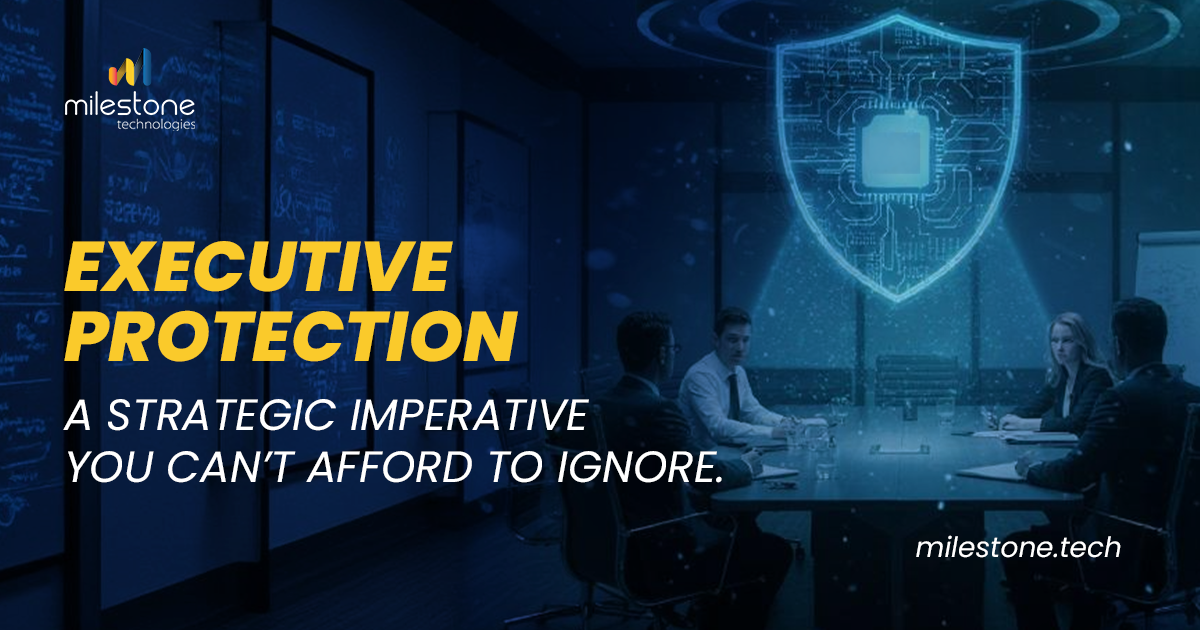First of a Three-Part Executive Protection Series
Executives are high value targets, carrying the keys to sensitive data, control over vast financial assets, and the power to shape strategic decisions. That makes them the first stop for cybercriminals, hostile actors, and even state sponsored adversaries. Today’s threat landscape—spanning AI driven impersonation, sophisticated social engineering, geopolitical targeting, and physical attacks—is escalating at a pace never seen before. Without immediate, intelligence driven security strategies, executive leadership remains dangerously exposed.
Let’s examine the urgent need for modern executive protection and explore why organizations must move beyond reactive security and adopt a proactive, intelligence-driven approach. What’s undeniable is that the paradigm is shifting, and enterprises can no longer afford to leave executive security to chance.
The Executive Risk Landscape Has Changed
In 2022, a Fortune 500 CEO fell victim to a spear-phishing scam involving a sophisticated deepfake audio that impersonated the company’s General Counsel. This resulted in a multi-million-dollar wire transfer to a fraudulent overseas account.
Source: Forbes – “Deepfake CEO Voice Used in $35M Fraud”
The spear-phishing attack prompted an immediate and wide-scale executive security review and is just one example highlighting how vulnerable leadership positions have become in the face of emerging technologies.
New-Age Threat Vectors for Leadership
Traditional risks have been surpassed by a new generation of threats that are highly targeted, persistent, and often invisible. Executives are increasingly subject to doxing, geo-tracking, surveillance via compromised devices, deepfake impersonations, and spear-phishing campaigns tailored using publicly available personal data.
A striking data point from the 2023 BlackBerry Global Threat Intelligence Report, produced in partnership with Corvus Insurance, reveals a 30% year-over-year increase in cyberattacks targeting executives and high-ranking personnel specifically. These attacks range from credential harvesting and business email compromise (BEC) to CEO impersonation attacks, often leading to direct financial losses and security breakdowns.
Source: BlackBerry Global Threat Intelligence Report Q3 2023
Compounding these issues is the reality of modern work culture. Executives frequently operate remotely, across time zones, from mobile devices, or in highly visible public engagements. Every touchpoint, from the hotel Wi-Fi to a casual social media post, can serve as an entry vector for malicious actors. The attack surface has expanded, and with it, the need for a coordinated defense.
The convergence of professional and personal digital footprints means executives are at risk in their offices, at home, while traveling, and even on social media. Three of the most urgent and converging risk areas currently facing executive leadership include:
- Residential Security Incidents – From sports professionals to business executives, there is a rise in attackers exploiting the softer security posture of private residences.
- Eavesdropping and Meeting Compromise – Hidden surveillance devices in boardrooms and executive offices not only jeopardize sensitive strategy and confidentiality, but can also undermine regulatory compliance and investor confidence.
- Cyber-led Impersonation and Deepfakes – Executives are being mimicked with alarming precision in voice, video, and written communication to authorize fraudulent wire transfers, mislead employees, erode stakeholder trust, and damage executive reputation.
The blurred lines between personal identity and corporate responsibility demand a more comprehensive and proactive approach to executive protection.
The Business Impact of Executive Vulnerabilities
When a cyber or physical breach targets an executive, the implications extend far beyond the individual. These events can disrupt operations, stall decision-making, and trigger regulatory scrutiny, especially in industries where executives are privy to sensitive data or govern compliance-critical processes.
The fallout can include:
- Operational disruption occurs when attackers compromise or monitor communications.
- Loss of investor confidence, resulting in share price volatility or stakeholder panic.
- Regulatory exposure, especially under privacy laws such as GDPR or CCPA.
- Reputational damage occurs when incidents make headlines and erode customer trust.
- Interference in strategic activities, such as M&A deals, IPOs, or confidential product launches.
Moreover, high-level breaches can lead to the loss of proprietary data, trade secrets, or IP, all of which are often directly linked to the executive suite. The fact is, executive vulnerability translates into enterprise risk, and organizations that fail to mitigate this exposure are leaving their future to chance.
Traditional Approaches Fall Short
Despite the high stakes, many organizations still rely on fragmented and reactive models of executive protection. These typically involve physical security details, firewalls, or isolated cybersecurity protocols, all functioning independently. Such siloed strategies are ill-equipped to counter the hybrid nature of modern threats, where a deepfake can serve as a precursor to a physical breach, or a phishing email can compromise an executive’s travel plans.
Legacy models fall short because:
- They are reactive, only responding after an incident occurs.
- They are siloed, with physical and digital security teams working in isolation.
- They lack threat intelligence, failing to detect or anticipate evolving tactics.
The future demands an intelligence-led, proactive framework that integrates physical security with real-time cyber monitoring, threat intelligence feeds, and behavioral analytics. Executive protection must evolve into a cross-functional risk mitigation strategy embedded within the broader enterprise resilience architecture.
Your Milestone Solution for Executive Protection
Executive protection today extends far beyond physical security. It encompasses safeguarding leaders against cyber threats, digital espionage, reputational risks, and covert surveillance that can compromise both personal safety and organizational stability. To be effective, it must align closely with enterprise risk, business continuity, and reputation management, requiring adaptive, intelligence-led strategies rather than piecemeal measures.
Milestone Technologies addresses this need through our Technical Surveillance Countermeasures (TSCM) Services. By combining advanced surveillance detection and mitigation, risk-based resource allocation, integrated IP security protocols, specialized training programs, and executive privacy awareness, we ensure:
- Executive environments and communications remain free from covert surveillance and espionage.
- Potential intrusions are identified early, neutralized effectively, and assessed comprehensively.
- TSCM efforts support organizational priorities, strengthening leadership continuity and resilience.
At Milestone, we protect the integrity of leadership, ensuring those who drive your organization forward remain shielded from surveillance, manipulation, and compromise.




